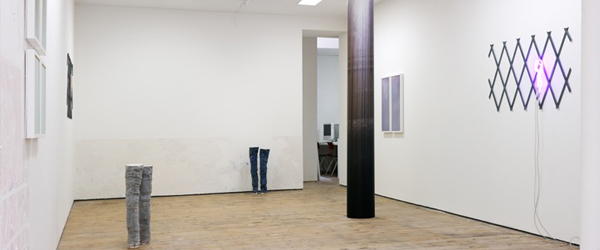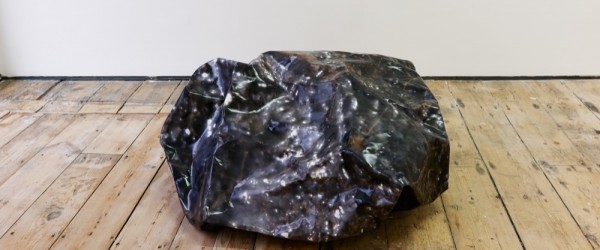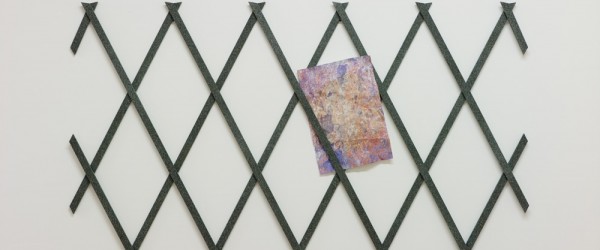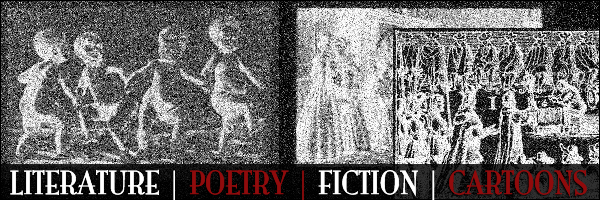
Chasing Nabokov
Art, Art News, Fine Art, Reviews“I do think that we largely delude ourselves with the knowledge that we think we possess, that we make it up as we go along, that we make it fit our desire and anxieties and that we invent a straight line or a trail in order to calm ourselves down” – W. G. Sebald (W. G. Sebald & James Wood, Brick, 1998)
Certain materials can undergo transformations so dramatic that they can be rendered unrecognisable without losing their physical self. It is so with the sculptural and photographic works of Clare Kenny, whose solo exhibition launched at VITRINE Bermondsey Street in October.
A photographic print of a curtain curls around a pillar, watched silently by the disembodied legs of the artists’ plaster-filled jeans. In ‘Yesterday’s labour is the Future’s folly’, anecdotes and memories from the artists’ life, both real and fabricated, combine with material manipulations that question substance and subject. In Kenny’s sculptures and print works, fact and fiction weave effortlessly.
It was this common ground that first led Kenny to the prose of W. B. Sebald and in particular, to his novel The Emigrants, which follows the lives of four emigrants who are both shaped and haunted by the memories they possess. Threading through these tales is the illusive figure of the Russian emigrant novelist Vladimir Nabokov, whose presence is felt alongside the characters variously as in a photograph, as the author of a characters’ reading or in a flashback to a mysterious episode in the life of a character.
As Sebald’s illusive envoy of fact, Nabrokov slips in and out of the character’s lives, neither a fictional entity – for links to the novelist all stem from concrete details regarding Nabokov’s life – nor, as the genre of novel necessitates – a factual absolute. The effect is a prose that sits on the dividing line between documentary and novel, pushing the reader to question the very nature of reality.
As Sebald’s writing requires a reader willing to walk the lines between fact and fiction, so Kenny’s art treads a hazy path between the real and the fabricated. Kenny rejects the idea of the narrator taking control of an account, instead presenting the viewer with a narrative, told through materials, to interpret as they wish.
In ‘Meteorite’, we see a sculptural effigy of a meteoroid, its surface mottled with all the pockmarks and pits of a prehistoric rock. The piece is born of the artists’ memory of a meteorite falling near her childhood home in Manchester. When Kenny consulted her sister on the matter, however, she purported to only remember Kenny’s previous articulation of the memory. A memory within a memory, the representation of the story teeters between fantastical and grounded.

The pieces’ solidity, like its premise, is ambivalent. What appears at a faraway glance to be a solid mass quickly transforms into a contorted photograph depicting the surface of a rock. Kenny has physically manipulated the print, coercing it to take the form of that which it depicted in two-dimensions. A material quirk demonstrates the artists’ playfulness; silver, which can be extracted from meteorites, is present in the print, tying the photograph back to the event depicted.
The same delight in material experimentation can be found in ‘Fiction follows form’ a wall-based piece comprised of a metal replication of a wooden garden trellice. Following this first manipulation, Kenny spray-painted the structure to achieve a stone effect, giving the piece an ambiguous materiality. The trellice acts as a frame for a print work that demonstrates a similarly complex series of transformation. ‘Granite’, whilst appearing to depict the material after which it is named, actually documents the mottled surface that results from laying a slab of plaster on top of wooden plank. A sister work, ‘Form follows fiction’, uses the trellice structure to support a neon form modeled on the artists’ hand-drawn sketch of a piece of rope.

In a series of framed works, spray paint overlays photographs of a spray-painted surface, creating a subtle dissonant between the texture of the real and the flatness of the documented. The muted colour palettes of ‘Beyond the pale’, ‘Pond Life’ and ‘Looking back at you’ marry the layers together almost seamlessly. The reward to the careful viewer is a glimpse at the collision of two pasts, famed in an ambivalent present.
In a back room, the artists’ memory is channelled through three photographs taken from apartment windows in Manchester, New York and Barcelona. Bent, scrunched, hole-punched and folded before being re-photographed, the prints have taken on a set of memories of their own. Their wavering connection to their original subjects somehow heightens their resonance as shifting souvenirs of the artists’ life.
Kenny is the thread that runs through the lives of each artwork, yet like the figure of Nabokov in Sebald’s novel, she is also the enigma that flees before any degree of conclusion can be reached. Having archived her memories in pictorial and material form, she then releases them, allowing them to take an independent stance; a monument to a life lived that is neither entirely the artists’ nor the viewers’.
‘Yesterday’s labour is the Future’s folly’ ran between 16 October and 23 November 2013 at VITRINE Bermondsey Street, London SE1 3UW. For more information, click here.























